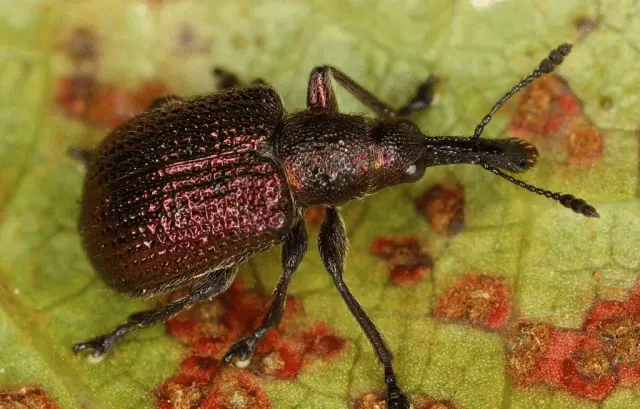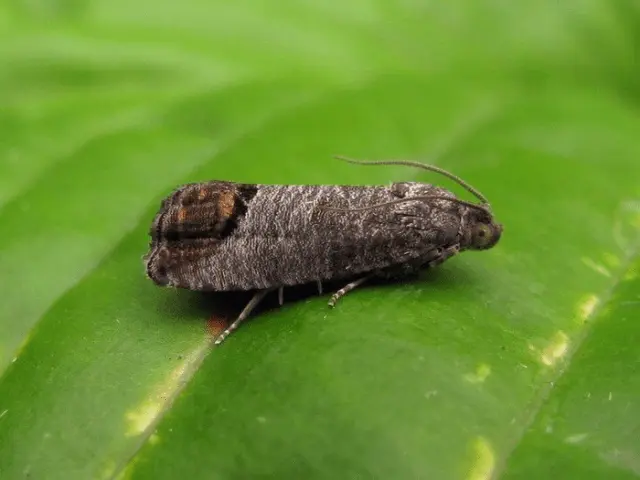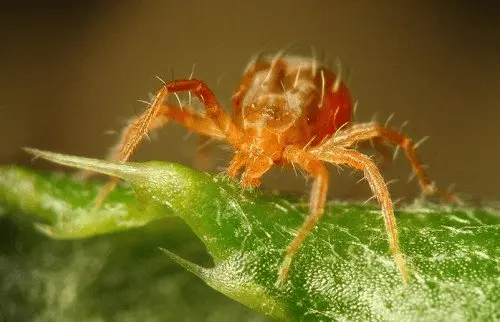Contents
Growing a peach on your own plot is not easy. The seedling may not be suitable for climatic conditions or soil quality. However, even when the tree takes root, the danger of being left without a crop does not pass. Peach pests can cause irreparable harm. Gardeners are always worried about how to deal with them, how to prevent their invasion. Below are the most effective pest control methods.
What harm do pests do to peach trees
Insects cause irreparable harm to green spaces, namely:
- destroy the stem part of the tree;
- spoil the fruit
- cause massive leaf fall;
- eat buds and peach blossoms.
Below is information about peach pests, their description and methods of treatment.
Peach tree pests
Peach is subject to attack by various pests. The most dangerous insects for a tree are such insects as:
- eastern codling moth;
- long-nosed;
- peach bark beetle;
- aphid;
- shield;
- fruit mite;
- fruit moth.
Gardeners should carry out the processing of green spaces in a timely manner in order to avoid the invasion of insects.

For example, aphids are small insects that suck the juice from the bark and shoots. In the autumn, to combat it, you can use a 2% solution of Bordeaux mixture. And after the fruits appeared on the tree, you can use Aktofit or Bi-58 New.
Oriental moth

Eastern codling moth belongs to butterflies from the leaf roller family. In cases where the codling moth is found in peaches during import, the fruits must be disinfected or destroyed without fail. The wings of the insect reach 15 mm in length. Females are slightly larger than males. The forewings have dark gray-brown tones, and light scales form transverse, wavy lines. Rapidly multiplying codling moths develop rapidly and cause irreparable harm to peach trees in a short period of time, depriving the gardener of the harvest.
Having made moves in the fruit, the insect leaves its excrement there, making the peach unfit for consumption. In the case when the attack of the pest is directed at the young ovary, it quickly rots and falls off. If young peach shoots are damaged, they can be expected to dry quickly.
In the fight against the eastern codling moth, any of the methods is aimed at reducing the number of insects. Below are tips to help deal with the peach pest:
- It is important to plow the aisle deeply, and the soil around the circumference of the trunks must be loosened in a timely manner. Such events make it possible to get rid of wintering pupae of the codling moth and prevent the mass summer of butterflies in early spring.
- Dead bark should be removed from trees in a timely manner and burned so that the codling moths have nowhere to winter.
- Fallen wormy peaches must be collected and buried in the ground (about 55-60 cm deep). It is best to collect scavengers before sunset. This will prevent the caterpillars from crawling onto other peaches.
- Shoots damaged by the eastern codling moth are pruned, which will help to significantly reduce the number of pests.
Dolgonosiki

Weevils belong to a large group of beetles. An adult weevil is able to pierce buds, buds and inflorescences. Insects eat stamens and pistils, green foliage and petals. In addition, weevils damage fruits by gnawing small holes in them and laying eggs there. Pests carry a large number of fungal diseases.
You can deal with insects with:
- chemical treatment of plantations, which is carried out until the buds swell;
- trapping belts, which are imposed above the trunk;
- trimming and removing buds with a brown top;
- cleaning branches and stem parts from dying bark;
- morning collection of bugs by shaking off insects on pre-laid oilcloth material;
- whitewashing the stem with lime mortar.
At the end of spring, it is effective to use preparations with entomopathogenic nematodes (for example, Nemabakt or Antonem-F). The agent is dissolved in water and the root part of the peaches is poured with the resulting liquid. Nematodes that enter the soil along with water kill insect pests.
Peach beetle

The bark beetle is one of the most dangerous pests that live on the peach tree. Bark beetles live in wood, feed on it and find a place to breed in it. The main signs of a bark beetle attack include the presence of:
- round holes on the stem, from which wood flour or shavings spill out;
- slight crackling that comes from eating a tree with beetles;
- woodpeckers on peach, which feed on bark beetles, extracting them from under the bark;
- traces of gum that appears when the peach tries to fight off the attack of pests on its own.
Pest control of the peach trunk consists of:
- Treatment of peach from pests with insecticides. The special chemical composition contained in the preparation kills the bark beetle. It is necessary to spray not only the stem part, but also the branches of plantings.
- Insecticide treatment is carried out in several stages. The interval between treatments should be 10-11 days. At this time, peaches need to be fed with immunostimulants. As soon as resin appears on the plant, you can be sure that the tree begins to fight the bark beetle on its own. It is best to use a preparation based on bifenthrin for treatments.
- Treatments with fumigating poisons that can paralyze the respiratory system of pests. After the bark beetles experience difficulty in breathing, they try to get to the surface.
- Fumigating poisons are sprayed onto the stem parts under high pressure. The poison begins to act already 30-40 minutes after the treatment. A second spraying procedure is recommended after a couple of weeks.
- The mechanical method, which consists in penetrating the holes made by the beetle with steel wire and manually extracting the insects. Treated passages should be filled with insecticides and treated with garden pitch.
Shield

The scale insect belongs to the family of semi-coleoptera insects that suck the juice from the bark, lay their eggs in it and hibernate there. The most dangerous for peach scale insects are Californian and mulberry. From the invasion of the pest, the shoots begin to curl and wither, the bark becomes loose and porous, and there is no fruiting. In some cases, peach fruits may become covered with red dots.
To combat the shield, experts recommend using:
- manual removal of the pest when they are found on a tree;
- systematic thinning of the peach crown.
In addition, it is necessary to destroy the root shoots and infected shoots in a timely manner. For processing a peach tree, a product prepared as follows is perfect:
- 350 g of tobacco are infused in 900 ml of water for 24 hours.
- After this, the infusion must be brought to a boil and add 45 g of laundry soap.
- Now you need to boil the liquid for 5 minutes, then add another 10 liters of water.
The prepared product must be sprayed on the trees in the spring. In the summer, it is best to use insecticides, namely:
- DNOC 40%;
- Iskra-M;
- “Fufanon”;
- “Aliot”.
You can see what a scale insect looks like on a peach in the photo above.
fruit moth

Fruit moth is a pest that destroys the buds and young shoots of peach. After eating the core, the shoots wither and die, the plant sheds foliage. Each of the caterpillars is capable of destroying more than 5 shoots. Reaching adulthood, the caterpillar hides in dry foliage or in the near-stem soil. In order to protect peach plantations from fruit moths, it is important:
- timely cut and burn damaged shoots;
- collect carrion and bury it in the ground to a depth of 55 cm;
- remove root shoots;
- regularly loosen the soil around the trunk;
- put trapping belts on the stem.
Photos of peach pests will help you figure out exactly how an insect that harms peach trees looks like.
fruit mite

Most often, peaches are attacked by brown fruit and peach leaf mites. The fusiform body of the tick reaches 200 mm in length. On the triangular shield one can see a well-developed visor with two spikes. In spring, the mites reach the inner part of the buds, settle on the rudiments of foliage and lay eggs.
Ticks, having sucked the juice from the foliage, contribute to the violation of the water balance, a decrease in the synthesis of chlorophyll and a violation of the processes of photosynthesis. The peach ceases to bear fruit abundantly, and the quality of the fruit leaves much to be desired.
Peach leaf mites, by their activity, cause the appearance of small spots of a yellow tint on the surface of the foliage. The extreme part of the foliage begins to bend inward.
A set of preventive measures
Timely preventive measures will help get rid of the invasion of pests. Information about peach pests, their control, photos of parasites will help develop a competent strategy for preventive measures. Below are the most effective prevention methods to help avoid pest attacks:
- With an annual mass attack of pests, it is recommended to use chemicals such as Karate, Neoron, Fitoverma, Agrovertina.
- Fallen leaves and weeds that grow near the peach trunk should be collected and destroyed in a timely manner. Leaves, weeds and branches are best burned in a fire, and the resulting ash can be used as fertilizer.
- In the autumn, it is recommended to carry out sanitary pruning of the crown. Removed shoots should be disposed of.
- In mid-November, it is important to dig up the near-stem soil, while turning over the layers of the earth. Pests wintering in the soil will thus remain on the surface of the earth and die from frost.
- Trunks and skeletal branches should be whitewashed in spring and autumn with lime mortar. To prepare it, you will need to add copper sulfate – 3% to a solution of slaked lime. In addition to lime, special garden paint is used for whitewashing.
- Conducting an annual spring spraying of the crown with a solution of Bordeaux liquid (copper sulfate) will get rid of most pests.
- In early spring, it is recommended to install trapping belts that you can make yourself.
Peach treatment from pests with insecticides must be carried out once before flowering and 2 times after it ends (interval – 2 weeks). The best drugs in this category were “Confidor” and “Calypso”. It is very important to strictly follow the dosage indicated by the manufacturer in the instructions.
Conclusion
Peach pests often prevent the grower from getting a good harvest. The peach is prone to most fungal diseases and is prone to insect attacks. Peach pest and disease control is a time-consuming, but still doable process. However, observing preventive measures, you can avoid the invasion of insects and the death of the plant. It is very important to systematically inspect trees so as not to miss the appearance of pests.
For more information about peach pests, see the video:










Thanks for your exciting article. One other problem is that mesothelioma is generally the result of the inhalation of fibers from mesothelioma, which is a cancer causing material. It truly is commonly observed among personnel in the construction industry who may have long experience of asbestos. It can be caused by living in asbestos covered buildings for some time of time, Genetics plays a crucial role, and some people are more vulnerable to the risk as compared to others.